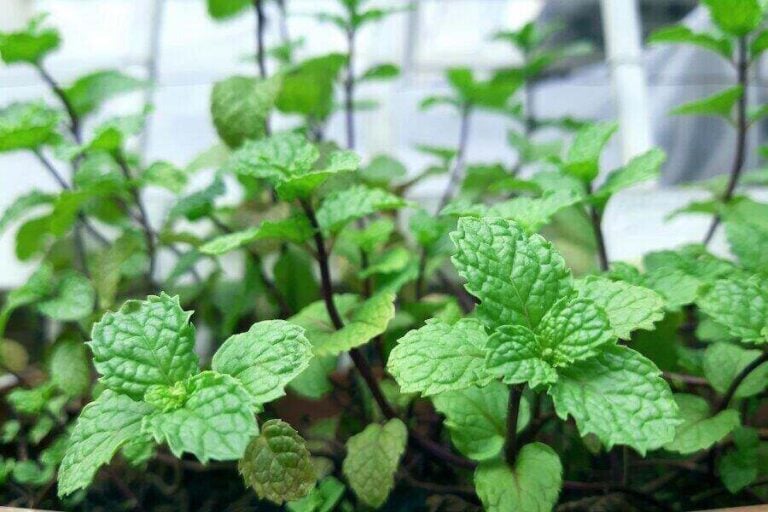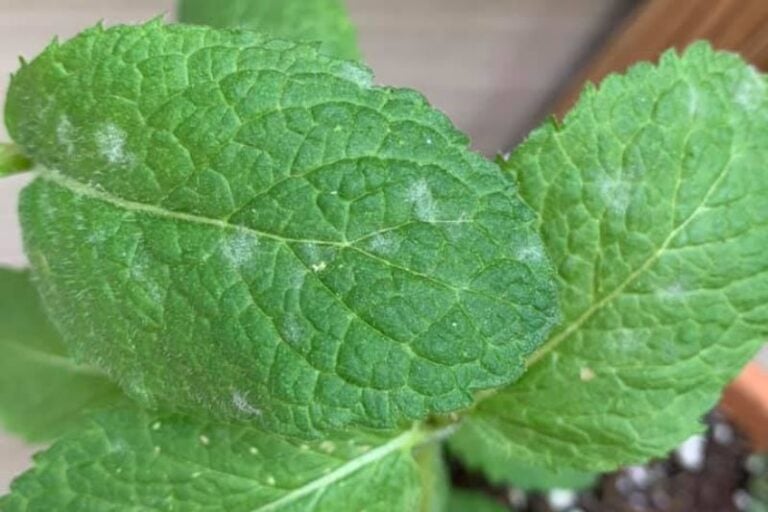You may be wondering why your mint leaves are turning black? Have you exhausted all of your options, but your mints’ health appears to be unaffected by them?
Luckily you came to the right place, the key to avoiding it is by applying and understanding the ideal conditions and essentials of growing mint plants.
Mint grows best in damp soil, and if the soil becomes extremely dry, the leaves may turn brown or even black. Mint leaves with low humidity transpire more water than necessary, resulting in dead leaf cells. Spray the plant or place the container on a tray of pebbles and water it between waterings.
Fortunately, you’ve come to the right place to learn about the ideal conditions and essentials of growing mint plants.
Contents
Causes Of Mint Leave Turning Black
Let us dive deep into the causes and solutions.
Poor Drainage
Mint has sensitive roots, hence inadequate drainage systems can add stress to the roots.
It thrives well in light soil that allows an easy flow of water to pass through it. A healthy root can sustain the plant and make it grow faster.
How to make a good drainage system?
First, ensure that you are using the right type of soil, next is to create 2-3 holes at the bottom of the pot.
The holes will allow only the minimum water required for the soil. It also helps to avoid a situation where you accidentally overwater it.
Over-fertilizing
Excess Fertilizing the plant can decrease plant growth and invite weeds to grow on it.
It makes it vulnerable to disease and the leaves eventually turn black. It is called fertilizer burn.
At the same time, the soil can dry out of nutrients, therefore it’s best to fertilize it once or twice a year to supply enough nutrients for plant growth.
You can easily determine the fertilizer dose by reading the instructions on the fertilizer package.
You can try organic plant food for herbs. It works great for any kind of herb.
How do I know I over fertilized?
Salts will build up on top of the soil, use a pH tester to check its value.
Below 7 reading indicates the high salt amount, you can minimize its presence by mixing it with other soil and creating a potting mix.
Temperature and Humidity
Mint plants are a quick-growing herb that develops best in full sun to fractional shade.
Direct exposure to high temperatures can dry up mint leaves and turn them black.
It is important to regulate it within its requirement from 69-84°F (21-29°C), but you need to shade it from the extreme temperature of the sun.
It thrives well into warm and not too humid environments.
Soil Type
Just like any other herb plant, you need to ensure rich and moist soil for mint.
Soil that is too dry and lacks moisture content makes it harder for herbs to grow.
So look for fertile soil such as loamy soil otherwise add organic compost on the top layer. Organic compost is affordable and easily available in stores.
This will help maintain the moisture content and provide enough nutrients for its growth.
Mint Rust
Due to fungal spore infestation mint rust appears on leaves. You will observe the mint leaves turning bright orange, yellow during late summer.
The color will ultimately change to black. You need to remove the infected part and isolate it from other plants. It can also spread to other nearby plants.
Here’s What You Need To Do
- First cut down the leaves or stems that have the above symptoms. This will minimize the spreading of diseases.
- It is better to get rid of the infected plants and destroy them completely.
- If the infection is low transfer them into the new potting soil after removing the infected parts.
Verticillium Wilt
Verticillium wilt comes from a fungus in the soil. Symptoms of these diseases include curling, twisting, and stunting of the upper leaves.
The infected leaves change their color from green to yellow and bronze.
Once fungi enter the soil, they stay there for many years. There is no fungicide treatment for it hence, best to get rid of the plant completely. (Source: Michigan State University)
Leaf Blight
Leaf blight of mint occurs during winter or cool weather. When the plant goes into a dormant stage that turns the entire leaves black.
Once you know winter is approaching, try moving it into a warmer environment or expose it to sunlight as much as you can.
You can transfer it indoors to keep its atmosphere warm.
It’s better to discard them off from other plants in order to stop their spread.
If you observe any of the above symptoms, try separating them off by cutting them on stems and leaves.
This can ensure the rest of the mint stems grow healthy. To guarantee that there is no transfer of fungus, just wash the rest of the healthy leaves with water.
You May Also Enjoy: Why Are My Mint Leaves Turning Purple? (And How to Fix It)
Pest
Pests that host mint include aphids, cutworms, thrips, and spider mites.
If you observe leaves turning yellow or brown, carefully check any tiny movements or unusual appearance of black, brown, yellow bodies on the mint leaves and stems.
They feed on leaves and create brown spots that create foliage on the stem. You can wash them with a force of water.
If they still appear then going for any insecticidal soap will be the best option.
Mint Aphid
Mint Aphid is one of the insects that can turn your mint leaves black. It is mostly green, yellow, black, or brown.
Aphid causes mint leaves to turn black and eventually die. You can apply any insecticidal soap or neem oil to it.
If there is an enormous presence of aphids, then spraying insecticides on it can do the job right.
Low light
With low light conditions, mint leaves can turn soggy and witty. This can cause the lower leaves to turn dry and gradually to black.
For that reason, you can still save it by cutting off the black leaves and letting it under sunlight for 6-7 hours, also make sure you do not overexpose it under sunlight for a long time.
However, if the base of the plant stem is brown or black, then it will be very difficult to save your mint.
How to Fix Low light
Do not feel limited by low light within your home. You can still grow mint and other herbs with the help of artificial light without any issues. If your apartment doesn’t have enough natural light then try using LED light. It will fix your low light problem.
You May Also Enjoy: Why Is My Mint Turning Brown? (And How to Fix It)
Here Are A Few Tips On How To Protect Your Mint Plant
Keeping these points in mind can help your plant feel less stress and grow healthy, it can be applied to any form of the herb. Take notes and give them what they need!
- Keep mint plants far away from pathways or driveways. This will ensure that it will be safe from dust, and other physical damage.
- Grow your mint in a herb growing pot, this will allow more room for it to grow.
- It needs regular watering and adequate lighting.
- Ensure soil is moist by touching the upper layer. You can always keep an alarm to remind you about watering it.
- It needs plenty of water during summer and ensures to plant the roots at least 3 inches deep with an additional 3 inches for it to reach its maximum growth at the root level.
- Young mint leaves are vulnerable to diseases and pests, always keep a lookout on it.
- Do not overexpose in direct sunlight, keep it in partial shading.
- Mint plants are salt intolerant, leach the soil with water three times to flush out any residues.
- Ideal soil pH levels should fall under the acidic value of 5.5-6
Why Grow Mint Plants?
Herbs bring flavor to life even in compact spaces, with the added benefit of always having fresh spice to your dishes.
Most herbs grow inside an orchard or home if you can provide the right conditions, including the right amount of light and temperature.
Herb plants will develop yellow to black foliage if it does not meet certain conditions.
Finally, if your mint leaves are turning black then the above mentioned actionable tips will solve your problem.







